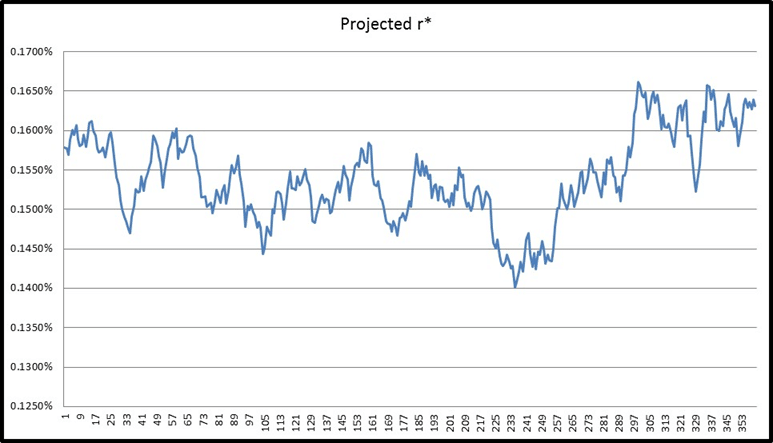What is the appropriate time step to use in estimating parameters for, and projecting short rates using, the CIR model? Can we use estimates based on daily time series data in an interest rate model that projects short rates at a monthly time interval?
The parameter estimates for instantaneous drift and volatility for the CIR interest rate model that we obtain from historical short rates data are dependent on the time series of rates we use for the exercise. If we use a daily short rate series the resulting parameters are daily estimates of the parameters; if we use a monthly series, the parameters will be monthly estimates.
This follows from the derived general recursive expression for r(ti) = γ(1 – e-к∆t) + e-к∆tr(ti-1) + ɛ(ti) using a discretization process of the CIR interest rate model. The interval [0; T] is evenly divided into N subintervals with ti = i T/N for i = 1, 2, …, n. Which calculates each time-step as ∆t = ti – ti-1.
Parameters estimated using a time step of ∆t are the:
- Instantaneous drift = к∆t
- Instantaneous volatility = σ√∆t
The estimated drift and volatility parameters from the time series data, already implies this time step.
For example, you infer the daily time step in the estimates when you use daily rates for the exercise. For daily rates (i.e. interval of [0,1], subdivided in 360 subintervals, assuming a 360 day year, the time step ∆t =1/360), the drift and volatility estimates are for к(1/360) & σ√(1/360) respectively.
Therefore, you cannot use daily parameter estimates to project or simulate interest rates series other than a daily rates series. For example, do not use daily estimates as is to project short rates at monthly time steps (dt = 1/12).
Solutions for the time step of your CIR Model
For monthly projections of short rates (i.e. interval of [0,1] subdivided in 12 or alternatively an interval of [0,30 (years)] subdivided in 360 subintervals, the time step ∆t =1/12), the daily parameter estimates could possibly only be used if:
- Drift and volatility estimates using a monthly time series of rates equal the drift and volatility estimates using daily rates series, based on the peculiarities of the time series data available,
OR
2. Approximate monthly estimates from daily estimates as follows:
- к(1/12) = к(1/360) * 360/12
- σ√(1/12) = σ√(1/360) * √(360/12)
Ideally, for parameter estimation, use historical time series consistent with the time step, dt, in the interest rate model. Use historical monthly series of short rates to estimate parameters for the interest rate model to project rates on a monthly time step (dt =1/12). Use historical daily series to estimate parameters for a model that uses a daily time step (dt = 1/360).

References:
- A covariance equivalent discretisation of the CIR model by Deelstra & Parker, and
- “Affine Term-Structure Models: Theory and Implementation by Bolder
